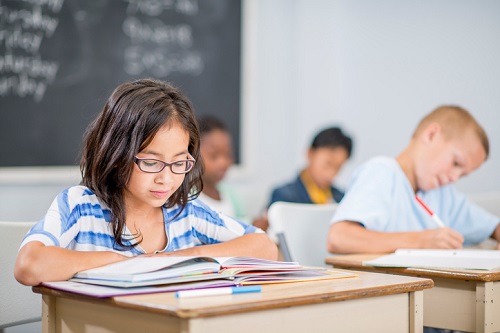
New research has added to the growing evidence linking nearsightedness to schooling, with researchers saying education systems must change to protect children’s vision.
The study, by the peer-reviewed BMJ (previously the British Journal of Medicine), found that the more years of schooling a child has, the higher his risk of developing nearsightedness – including early-onset myopia, which can lead to blindness.
The researchers, from the University of Bristol and Cardiff University, used the UK Biobank sample to perform a study using genetic variants associated with myopia and with years of education.
For the study, the researchers analysed genetic and background information – including years of education and eyesight – from nearly 68,000 adults who took part in a series of genetic studies.
They found that every year of education incrementally increases a student’s short-sightedness to the extent that the average person with 20/20 vision who left school at 16 would legally need glasses to drive by the time they were a university graduate.
As societies have developed formal education systems, the prevalence of myopia has increased from around 1% to as much as 80-90% in young adults.
The authors note that there has been a trend to increasingly early onset of myopia in the school years in East Asia.
“This is probably due to early intense educational pressures such as homework at preschool level, combined with little time for play outdoors,” the researchers pointed out.
“As a result, almost 50% of children in East Asia are now myopic by the end of primary school, compared with less than 10% in the British study.”
According to the researchers, this early onset allows more time for myopia to progress to high and potentially pathological myopia, and this is probably the major concern with the myopia epidemic.
Fortunately, the prevention of both myopia onset and progression now seems possible.
“The epidemiological evidence, even without this study, was so strong that school based myopia control began some years ago in East Asia,” the authors said.
“Increased time outdoors seems to slow the onset of myopia and was adopted for school based control of myopia in Taiwan in 2010.”
School based myopia control has an even longer history in mainland China, although the eye exercises introduced more than 50 years ago have obviously not prevented an epidemic of myopia.
However, the researchers cautioned that fundamental reform of the East Asian schooling systems – characterised by early onset of educational pressures and streaming by performance – has not yet been attempted.
Instead, the regular release of the international PISA (Programme for International Student Assessment) surveys of educational outcomes, with league tables dominated by the East Asian countries with epidemic levels of myopia, regularly leads to calls for other countries to emulate East Asian schooling.
“In response, we need to remember that East Asian education systems have played a major role in producing the current epidemic of myopia and high myopia, and that these systems will require substantial change to help protect the vision of future generations,” the researchers concluded.
Related stories:
Is a four-day school week a good idea?
Research highlights value of outdoor education
The link between student behaviour and language


